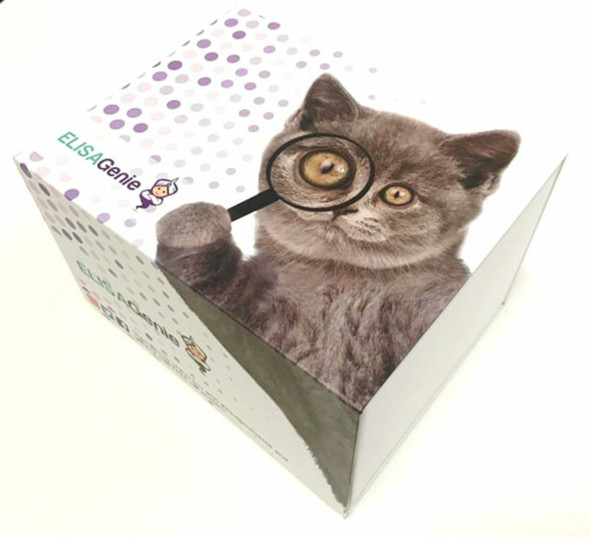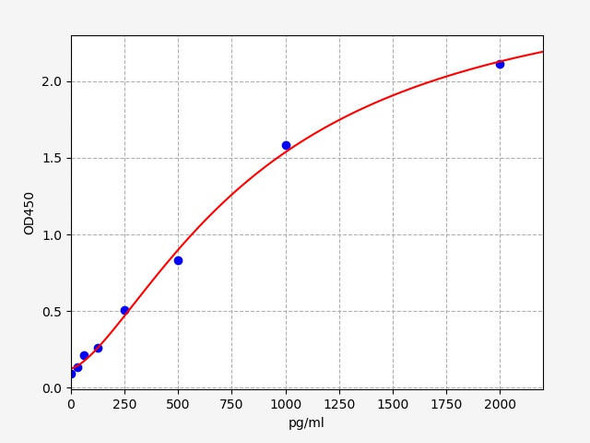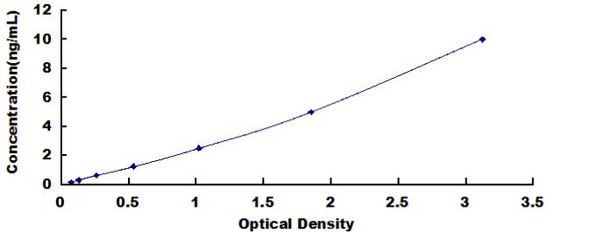Human Immunology ELISA Kits 1
Human PADI4 (Peptidyl Arginine Deiminase Type IV) CLIA Kit (HUES00765)
- SKU:
- HUES00765
- Product Type:
- ELISA Kit
- ELISA Type:
- CLIA Kit
- Size:
- 96 Assays
- Sensitivity:
- 37.5pg/mL
- Range:
- 62.5-4000pg/mL
- ELISA Type:
- Sandwich
- Synonyms:
- PAD, PAD4, PADI5, PDI4, PDI5
- Reactivity:
- Human
- Sample Type:
- Serum, plasma and other biological fluids
- Research Area:
- Immunology
Description
| Assay type: | Sandwich |
| Format: | 96T |
| Assay time: | 4.5h |
| Reactivity: | Human |
| Detection method: | Chemiluminescence |
| Detection range: | 62.50-4000 pg/mL |
| Sensitivity: | 37.50 pg/mL |
| Sample volume: | 100µL |
| Sample type: | Serum, plasma and other biological fluids |
| Repeatability: | CV < 15% |
| Specificity: | This kit recognizes Human PADI4 in samples. No significant cross-reactivity or interference between Human PADI4 and analogues was observed. |
This kit uses Sandwich-CLIA as the method. The micro CLIA plate provided in this kit has been pre-coated with an antibody specific to Human PADI4. Standards or samples are added to the appropriate micro CLIA plate wells and combined with the specific antibody. Then a biotinylated detection antibody specific for Human PADI4 and Avidin-Horseradish Peroxidase (HRP) conjugate are added to each micro plate well successively and incubated. Free components are washed away. The substrate solution is added to each well. Only those wells that contain Human PADI4, biotinylated detection antibody and Avidin-HRP conjugate will appear fluorescence. The Relative light unit (RLU) value is measured spectrophotometrically by the Chemiluminescence immunoassay analyzer. The RLU value is positively associated with the concentration of Human PADI4. The concentration of Human PADI4 in the samples can be calculated by comparing the RLU of the samples to the standard curve.
| UniProt Protein Function: | PADI4: Catalyzes the citrullination/deimination of arginine residues of proteins. Citrullinates histone H3 at 'Arg-8' and/or 'Arg-17' and histone H4 at 'Arg-3', which prevents their methylation by CARM1 and HRMT1L2/PRMT1 and represses transcription. Citrullinates EP300/P300 at 'Arg-2142', which favors its interaction with NCOA2/GRIP1. Genetic variations in PADI4 are a cause of susceptibility to rheumatoid arthritis (RA). It is a systemic inflammatory disease with autoimmune features and a complex genetic component. It primarily affects the joints and is characterized by inflammatory changes in the synovial membranes and articular structures, widespread fibrinoid degeneration of the collagen fibers in mesenchymal tissues, and by atrophy and rarefaction of bony structures. Could have an important role in the pathogenesis of rheumatoid arthritis by increasing citrullination of proteins in rheumatoid arthritis synovial tissues, leading, in a cytokine-rich milieu, to a break in tolerance to citrullinated peptides processed and presented in the appropriate HLA context. Belongs to the protein arginine deiminase family. |
| UniProt Protein Details: | Protein type:Nuclear receptor co-regulator; Hydrolase; EC 3. 5. 3. 15 Chromosomal Location of Human Ortholog: 1p36. 13 Cellular Component: cytoplasm; nucleus Molecular Function:arginine deiminase activity; protein binding; calcium ion binding; protein-arginine deiminase activity Biological Process: chromatin remodeling; nucleosome assembly; transcription, DNA-dependent; regulation of transcription, DNA-dependent; stem cell maintenance; innate immune response; protein modification process; chromatin modification; peptidyl-citrulline biosynthetic process from peptidyl-arginine Disease: Rheumatoid Arthritis |
| NCBI Summary: | This gene is a member of a gene family which encodes enzymes responsible for the conversion of arginine residues to citrulline residues. This gene may play a role in granulocyte and macrophage development leading to inflammation and immune response. [provided by RefSeq, Jul 2008] |
| UniProt Code: | Q9UM07 |
| NCBI GenInfo Identifier: | 296439260 |
| NCBI Gene ID: | 23569 |
| NCBI Accession: | Q9UM07. 2 |
| UniProt Related Accession: | Q9UM07 |
| Molecular Weight: | |
| NCBI Full Name: | Protein-arginine deiminase type-4 |
| NCBI Synonym Full Names: | peptidyl arginine deiminase 4 |
| NCBI Official Symbol: | PADI4 |
| NCBI Official Synonym Symbols: | PAD; PAD4; PDI4; PDI5; PADI5 |
| NCBI Protein Information: | protein-arginine deiminase type-4 |
| UniProt Protein Name: | Protein-arginine deiminase type-4 |
| UniProt Synonym Protein Names: | HL-60 PAD; Peptidylarginine deiminase IV; Protein-arginine deiminase type IV |
| Protein Family: | Lipase |
| UniProt Gene Name: | PADI4 |
| UniProt Entry Name: | PADI4_HUMAN |
As the RLU values of the standard curve may vary according to the conditions of the actual assay performance (e. g. operator, pipetting technique, washing technique or temperature effects), the operator should establish a standard curve for each test. Typical standard curve and data is provided below for reference only.
| Concentration (pg/mL) | RLU | Average | Corrected |
| 4000 | 55460 62702 | 59081 | 59046 |
| 2000 | 26160 29558 | 27859 | 27824 |
| 1000 | 14002 12966 | 13484 | 13449 |
| 500 | 6350 6860 | 6605 | 6570 |
| 250 | 3349 3137 | 3243 | 3208 |
| 125 | 1649 1513 | 1581 | 1546 |
| 62.50 | 714 796 | 755 | 720 |
| 0 | 33 37 | 35 | -- |
Precision
Intra-assay Precision (Precision within an assay): 3 samples with low, mid range and high level Human PADI4 were tested 20 times on one plate, respectively.
Inter-assay Precision (Precision between assays): 3 samples with low, mid range and high level Human PADI4 were tested on 3 different plates, 20 replicates in each plate.
| Intra-assay Precision | Inter-assay Precision | |||||
| Sample | 1 | 2 | 3 | 1 | 2 | 3 |
| n | 20 | 20 | 20 | 20 | 20 | 20 |
| Mean (pg/mL) | 196.88 | 406.01 | 1941.91 | 213.15 | 388.35 | 1806.50 |
| Standard deviation | 21.26 | 39.75 | 205.84 | 27.41 | 35.34 | 134.04 |
| C V (%) | 10.80 | 9.79 | 10.60 | 12.86 | 9.10 | 7.42 |
Recovery
The recovery of Human PADI4 spiked at three different levels in samples throughout the range of the assay was evaluated in various matrices.
| Sample Type | Range (%) | Average Recovery (%) |
| Serum (n=5) | 98-110 | 103 |
| EDTA plasma (n=5) | 99-114 | 106 |
| Cell culture media (n=5) | 88-100 | 95 |
Linearity
Samples were spiked with high concentrations of Human PADI4 and diluted with Reference Standard & Sample Diluent to produce samples with values within the range of the assay.
| Serum (n=5) | EDTA plasma (n=5) | Cell culture media (n=5) | ||
| 1:2 | Range (%) | 96-108 | 100-112 | 102-116 |
| Average (%) | 101 | 107 | 108 | |
| 1:4 | Range (%) | 96-110 | 90-103 | 90-104 |
| Average (%) | 102 | 97 | 98 | |
| 1:8 | Range (%) | 91-106 | 101-115 | 98-111 |
| Average (%) | 97 | 107 | 104 | |
| 1:16 | Range (%) | 101-117 | 100-116 | 90-102 |
| Average (%) | 108 | 107 | 95 |
An unopened kit can be stored at 4°C for 1 month. If the kit is not used within 1 month, store the items separately according to the following conditions once the kit is received.
| Item | Specifications | Storage |
| Micro CLIA Plate(Dismountable) | 8 wells ×12 strips | -20°C, 6 months |
| Reference Standard | 2 vials | |
| Concentrated Biotinylated Detection Ab (100×) | 1 vial, 120 µL | |
| Concentrated HRP Conjugate (100×) | 1 vial, 120 µL | -20°C(shading light), 6 months |
| Reference Standard & Sample Diluent | 1 vial, 20 mL | 4°C, 6 months |
| Biotinylated Detection Ab Diluent | 1 vial, 14 mL | |
| HRP Conjugate Diluent | 1 vial, 14 mL | |
| Concentrated Wash Buffer (25×) | 1 vial, 30 mL | |
| Substrate Reagent A | 1 vial, 5 mL | 4°C (shading light) |
| Substrate Reagent B | 1 vial, 5 mL | 4°C (shading light) |
| Plate Sealer | 5 pieces | |
| Product Description | 1 copy | |
| Certificate of Analysis | 1 copy |
- Set standard, test sample and control (zero) wells on the pre-coated plate and record theirpositions. It is recommended to measure each standard and sample in duplicate. Note: addall solutions to the bottom of the plate wells while avoiding contact with the well walls. Ensuresolutions do not foam when adding to the wells.
- Aliquot 100µl of standard solutions into the standard wells.
- Add 100µl of Sample / Standard dilution buffer into the control (zero) well.
- Add 100µl of properly diluted sample (serum, plasma, tissue homogenates and otherbiological fluids. ) into test sample wells.
- Cover the plate with the sealer provided in the kit and incubate for 90 min at 37°C.
- Aspirate the liquid from each well, do not wash. Immediately add 100µL of BiotinylatedDetection Ab working solution to each well. Cover the plate with a plate seal and gently mix. Incubate for 1 hour at 37°C.
- Aspirate or decant the solution from the plate and add 350µL of wash buffer to each welland incubate for 1-2 minutes at room temperature. Aspirate the solution from each well andclap the plate on absorbent filter paper to dry. Repeat this process 3 times. Note: a microplatewasher can be used in this step and other wash steps.
- Add 100µL of HRP Conjugate working solution to each well. Cover with a plate seal andincubate for 30 min at 37°C.
- Aspirate or decant the solution from each well. Repeat the wash process for five times asconducted in step 7.
- Add 100µL of Substrate mixture solution to each well. Cover with a new plate seal andincubate for no more than 5 min at 37°C. Protect the plate from light.
- Determine the RLU value of each well immediately.






